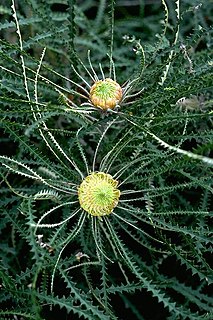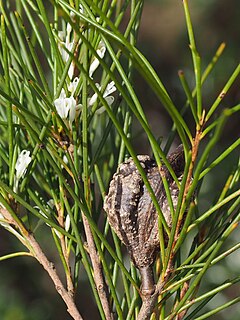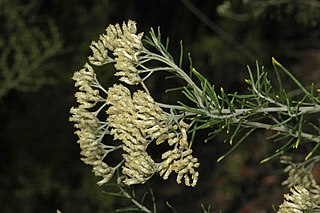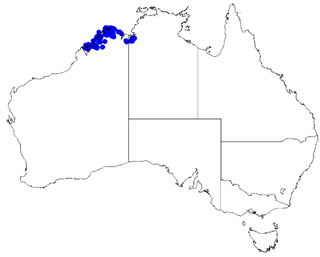Related Research Articles

Banksia lanata is a species of shrub that is endemic to a restricted area of Western Australia. It has linear leaves, pale cream-coloured flowers in a head with whitish bracts at the base and later up to fifty elliptical follicles in each head.

Banksia audax is a species of shrub that is endemic to Western Australia. It has fissured, grey bark, woolly stems, hairy, serrated leaves and golden orange flower spikes.
Banksia biterax is a species of dense shrub that is endemic to Western Australia. It has hairy stems, deeply serrated leaves and spikes of up to 200 pale to dark brown flowers.

Banksia mucronulata, commonly known as swordfish dryandra, is a species of shrub that is endemic to Western Australia. It has spreading, hairy stems, linear, deeply pinnatifid leaves with sharply-pointed lobes, pale yellow to cream-coloured flowers in heads of between 80 and 180, and egg-shaped follicles.

Ozothamnus secundiflorus is an aromatic shrub species, endemic to Australia. It grows to between 0.5 and 2 metres in height. Leaves are 6 to 10 mm long and 1.5 to 4 mm wide. These are dark green with grey hairs on the upper surface, and white tomentose below. The white flower heads appear in dense clusters along one side of the stem between December and February in the species' native range.
Melaleuca stramentosa is a plant in the myrtle family, Myrtaceae and is endemic to the south-west of Western Australia. It is a small, bushy shrub similar to Melaleuca similis with its cylindrical leaves and heads of pink to purple flowers but differs in have matted, woolly hairs around the flowers and on the young leaves.

Hakea ochroptera is a species of flowering plant in the family Proteaceae and is endemic to a restricted area of New South Wales. It is a shrub with long, needle-shaped leaves and an abundance of cream-white flowers in spring.

Hakea tephrosperma commonly known as hooked needlewood, is a shrub or small tree species in the family Proteaceae. It has cream flowers, needle-shaped leaves and is one of the taller species adaptable for dry to temperate locations.

Cassinia tenuifolia, commonly known as bully bush or killmoke, is a species of flowering plant in the family Asteraceae and is endemic to Lord Howe Island. It is a dense, bushy shrub with hairy young stems, crowded linear leaves and sweetly scented flower heads arranged in corymbs.

Cassinia uncata, commonly known as sticky cassinia, is a species of flowering plant in the family Asteraceae and is native to inland New South Wales and the south-east of South Australia. It is an erect shrub with hairy young stems, narrow linear to needle-shaped leaves, and heads of off-white to cream-coloured flowers arranged in rounded, almost conical panicles.
Cassinia monticola commonly known as mountain cassinia, is a species of flowering plant in the family Asteraceae and is endemic to mountain areas of south-eastern Australia. It is a spreading shrub with sticky, narrow linear to narrow lance-shaped leaves, and bronze-coloured to greenish-cream heads of flowers arranged in a dense, round-topped corymb.
Cassinia straminea is a species of flowering plant in the family Asteraceae and is endemic to eastern Australia. It is an erect shrub with hairy young stems, linear leaves and corymbs of up to several hundred flower heads.

Hakea newbeyana is a shrub in the family Proteaceae and is endemic to an area in the southern Wheatbelt and Goldfields-Esperance regions of Western Australia. It is a prickly shrub with smooth grey bark and sweetly scented cream-yellow flowers in profusion in spring.

Hemiphora elderi, commonly known as red velvet, is a flowering plant in the mint family Lamiaceae and is endemic to the south-west of Western Australia. It is a small shrub with its leaves densely covered with white, woolly hairs and with small clusters of reddish-purple, bell-shaped flowers.

Leucospermum pedunculatum is an evergreen, low shrub of 15–30 cm (½–1 ft) high spreading from a single stern upright stem, from the family Proteaceae. The powdered or hairless line-shaped to somewhat sickle-shaped leaves are 3–6 cm (1.2–2.4 in) long and 2–5 mm (0.08–0.20 in) wide. The stalked, individually set flower heads are globe-shaped, 2½−3 cm in diameter consist of initially white to pale cream flowers that eventually turn carmine. From the center of the flowers emerge straight styles that jointly give the impression of a pincushion. It is called white-trailing pincushion in English. It flowers from August to January, peaking in September. It is an endemic species that is restricted to a narrow strip on the south coast of the Western Cape province of South Africa.
Olearia adenolasia, commonly known as woolly-glandular daisy-bush, is a species of flowering plant in the family Asteraceae. It is a small upright shrub with sticky leaves and blue-purple or white daisy flowers.

Boronia wilsonii is an erect shrub that is endemic to northern Australia. Its branches, leaves and backs of the flowers are densely covered with woolly hairs. The petals are white to pink or burgundy-coloured.
Cassinia complanata, commonly known as smooth cassinia, is a species of flowering plant in the family Asteraceae and is endemic to south-eastern Australia. It is a shrub with sticky, densely hairy stems, narrow linear to cylindrical leaves and heads of small flowers arranged in corymbs.
Cassinia ozothamnoides, commonly known as cottony haeckeria, is a species of flowering plant in the family Asteraceae and is endemic to Victoria, Australia. It is an erect shrub with hairy branchlets, linear leaves and corymbs of up to two hundred flower heads.
Cassinia thinicola is a species of flowering plant in the family Asteraceae and is endemic to coastal New South Wales. It is a compact shrub with hairy young stems, needle-shaped to slightly flattened leaves, and corymbs of up to 150 flower heads.
References
- ↑ "Ozothamnus tesselatus". Australian Plant Census. Retrieved 26 December 2021.
- ↑ Bell, Stephen; Rockley, Christine; Llewellyn, Anne (2019). Flora of the Hunter Region. Victoria: CSIRO. p. 92. ISBN 9781486311026.
- ↑ Everett, J. "Ozothamnus tesselatus". PlantNET-NSW flora online. Royal Botanic Garden Sydney. Retrieved 27 December 2021.